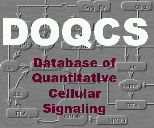
|
Enter a Search String | | Special character and space not allowed in the query term.
Search string should be at least 2 characters long. |
Molecule Parameter List for mGluR | The statistics table lists the distribution of a molecule acting either as a substrate, product, enzyme or as a molecule within the network.
The text color of a molecule is highlighted by  color. color. | | Statistics |
| mGluR participated as | Molecule | Sum total of | Enzyme | Substrate of an enzyme | Product of an enzyme | Substrate in Reaction | Product in Reaction | | No. of occurrences | 1 | 0 | 0 | 0 | 0 | 2 | 0 |
Accession and Pathway Details | |
| Accession Name | Accession No. | Accession Type | Pathway Link | Osc_Ca_
IP3metabolism | 24 | Network |
MIPP, CaMKII, CaM,
PKC, IP3-3K, Gq,
PLCbeta, 134_dephos, 145_dephos,
IP4-system, IHP-system, 1345_dephos,
CaRegulation, Othmer-Tang-model | | This network models an oscillatory calcium response to GPCR mediated PLCbeta activation, alongwith detailed InsP3 metabolism in the neuron. It differs from the NonOsc_Ca_IP3metabolism network in the CaRegulation module and in InsP3 receptor kinetics. Details of InsP3 receptor kinetics have been adapted from the Othmer-Tang model for oscillatory Ca dynamics. Mishra J, Bhalla US. Biophys J. 2002 Sep;83(3):1298-316. |
mGluR acting as a Molecule in Osc_Ca_IP3metabolism Network
| Name | Accession Name | Pathway Name | Initial Conc.
(uM) | Volume
(fL) | Buffered | | mGluR | Osc_Ca_
IP3metabolism
Accession No. : 24 | Gq
Pathway No. : 125 | 0.3 | 1000 | No | | From Mahama and Linderman, Total # of receptors/cell = 1900 However, the density is likely to be very high at the synapse. Fay et al Biochem 30 5066-5075 1991 have a value of 60K receptors per cell for neutrophils which comes to 0.1 uM. Here we have a situation where trying to represent the synapse by a 10 micron cube gives awkward results. I will scale up to 0.3 uM since synaptic receptor density is likely to be higher, with the caveat that I should really be using a more geometrically realistic model. |
mGluR acting as a Substrate in a reaction in Osc_Ca_IP3metabolism Network
| Kd is calculated only for second order reactions, like nA+nB <->nC or nA<->nC+nD, where n is number and A,B,C,D are molecules, where as for first order reactions Keq is calculated.
Kd for higher order reaction are not consider. |
| | Name | Accession Name | Pathway Name | Kf | Kb | Kd | tau | Reagents | | 1 | RecLigandBinding | Osc_Ca_
IP3metabolism
Accession No. : 24 | Gq
Pathway No. : 125 | 16.8
(uM^-1 s^-1) | 10
(s^-1) | Kd(bf) = 0.5952(uM) | - | Substrate
Glu
mGluR
Product
Rec-Glu
| | | From Martin et al FEBS Lett 316:2 191-196 1993 we have Kd = 600 nM Assuming kb = 10/sec, we get kf = 10/(0.6 uM * 6e5) = 2.8e-5 1/sec/# The off time for Glu seems pretty slow: Nicoletti et al 1986 PNAS 83:1931-1935 and Schoepp and Johnson 1989 J Neurochem 53 1865-1870 indicate it is at least 30 sec. Here we are a little faster because this is only a small part of the off rate, the rest coming from the Rec-Gq complex. | | 2 | Rec-bind-Gq | Osc_Ca_
IP3metabolism
Accession No. : 24 | Gq
Pathway No. : 125 | 0.6
(uM^-1 s^-1) | 1
(s^-1) | Kd(bf) = 1.6667(uM) | - | Substrate
G-GDP
mGluR
Product
Rec-Gq
| | | From Berstein et al 1992 JBC 267(12):8081-8088 we know that 15-40% of Gq binds, GTP_gamma_S. Also about 20-30% of Gq is bound to GTP. To get to these values the receptor-Gq amount should be similar. These rates are designed to give that steady state with a fast tau of 1 sec. |
| Database compilation and code copyright (C) 2022, Upinder S. Bhalla and NCBS/TIFR
This Copyright is applied to ensure that the contents of this database remain freely available. Please see FAQ for details. |
|
